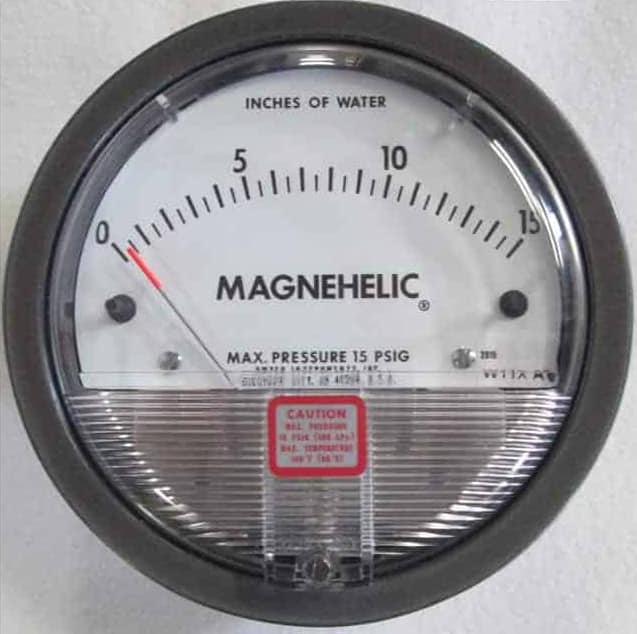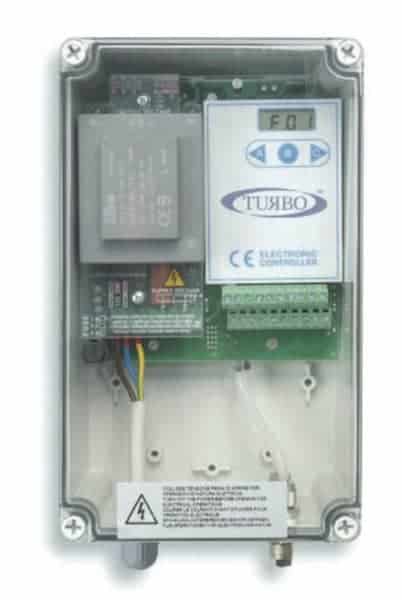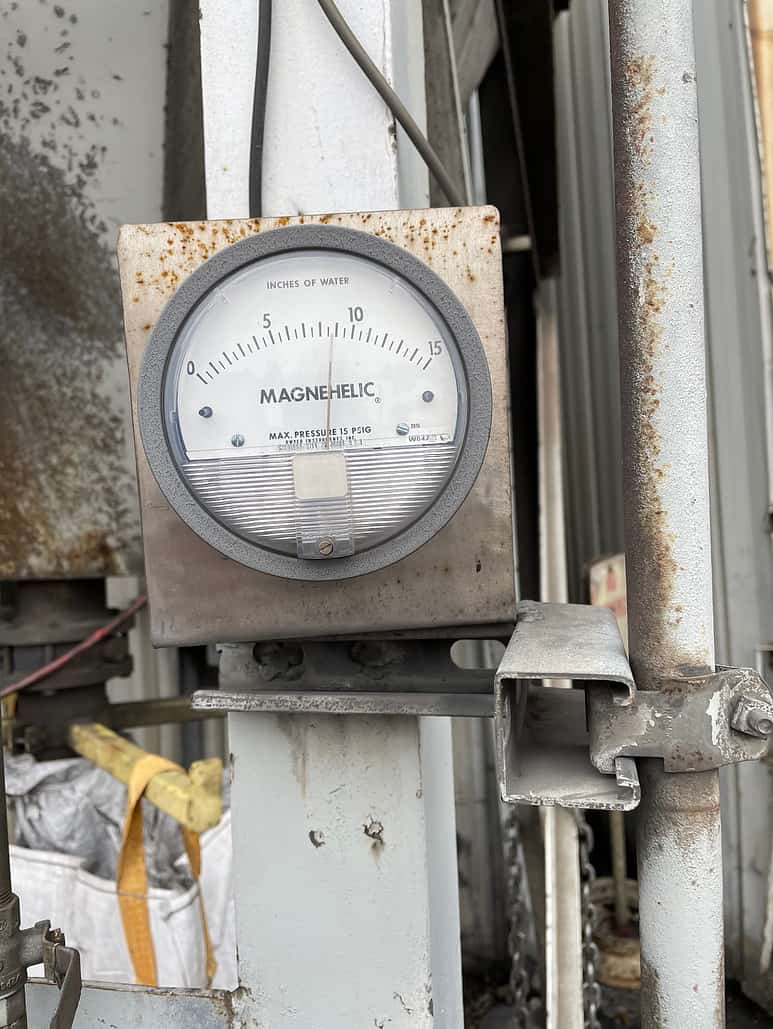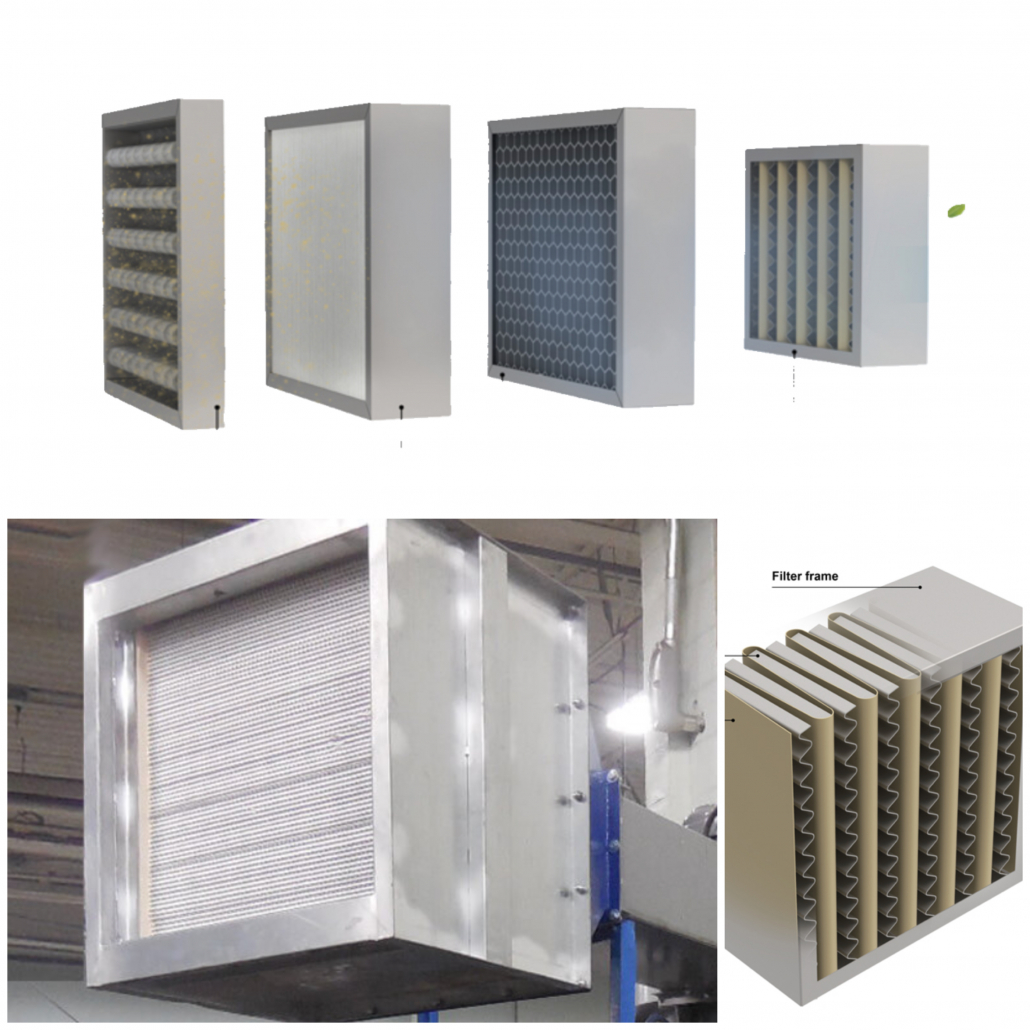A Primer on Pressure Gauges for Dust Collection Systems
Contents
How Differential Pressure Gauges are Used in Dust Collection Systems
How to Use a Magnahelic (Differential Pressure) Gauge to Measure Dust Collector Performance
What is the Expected Range of Static Pressure Drop Across a Baghouse?
Can Static Pressure Drop be “Too Low”?
How to Select a Differential Pressure Gauge
Integrated Differential Pressure Gauges
Magnahelic vs Photohelic Gauges
How are Flow Sensors Used to Measure Dust Collector Performance?
Pressure Gauge Maintenance
Purchasing a Differential Pressure Gauge
How Differential Pressure Gauges are Used in Dust Collection Systems

Standard 0-15 in WG Magnahelic Differential Pressure Gauge
When inspecting or evaluating a dust collector (baghouse, cartridge collector, etc.) or dust collection system, you will see various gauges installed at different locations in the system. These sensors are in place to help you monitor and control the performance of the system. The most common gauges you will find are:
- Differential pressure gauge: Often referred to as a Magnahelic Gauge (Magnahelic is a specific brand name, but many people refer to all DP gauges as ‘Magnahelics’), a differential pressure gauge is typically installed on or adjacent to the dust collector. It measures the pressure drop across the filters in your dust collector. The gauge consists of two pressure ports that are connected to either side of the filters. As dust accumulates on the filters, the pressure drop across them increases. The differential pressure gauge measures this pressure drop and provides a reading that indicates when the filters need to be cleaned or replaced. This helps to maintain the efficiency of the dust collector and prevent damage to the system. It is also a useful metric to track daily, weekly, and monthly to monitor the health of your filters and filter cleaning system.
- Static pressure gauge: A static pressure gauge may be installed at various points in the ductwork of a dust collection system to measure the static pressure of the system. By monitoring the static pressure at different points, operators can identify areas of the system that may be causing airflow restrictions or problems with the system. This can help to diagnose issues with the system and optimize its performance. You will also likely see a standard pressure gauge on your compressed air line if using a pulse jet style dust collector.
- Flow sensor: A flow sensor is typically installed in the ductwork of a dust collection system to measure the airflow rate of the system. The sensor typically consists of a probe that is inserted into the ductwork, and it measures the velocity of the air passing through the duct. By combining this measurement with the cross-sectional area of the duct, the flow sensor can provide an accurate measurement of the airflow rate. This information is useful for optimizing the performance of the system and maintaining a safe working environment for operators. Flow sensors are less common with simple dust collection systems but are an inexpensive way to ensure your airflow stays within range.
How to Use a Magnahelic (Differential Pressure) Gauge to Measure Dust Collector Performance
The static pressure drop measurement is a critical parameter in assessing the performance of a dust collector because it provides real-time information about the condition of the filter and the overall efficiency of the system. As the filter accumulates more dust particles, the static pressure drop increases, which reduces the airflow and negatively impacts the dust collector’s performance.
If you watch the gauge for a few minutes, you will see the differential pressure slowly rise as dust accumulates on the filters. When the pulse jets fire (you will hear the blast of compressed air), you will see the pressure drop as the dust cake is knocked off the filters by a blast of compressed air, allowing more air flow through the filters.
By monitoring the static pressure drop over time, maintenance personnel can determine when it is time to clean or replace the filter to maintain optimal performance. Regular monitoring of the static pressure drop also helps identify any unexpected issues with the dust collector’s design or operation that may be causing excessive filter clogging or decreased airflow.
What is the Expected Range of Static Pressure Drop Across a Baghouse?
The expected range of static pressure drop (also referred to as differential pressure, or “DP”) across a baghouse dust collector can vary depending on several factors, including the type of baghouse, the type of filters used, the airflow rate, and the properties of the dust being collected.
Generally speaking, a static pressure drop of 3-6 inches of water column (WC) is considered normal for a baghouse dust collector. However, the pressure drop can range from as low as 1 inch WC to as high as 10 inches WC or more, depending on the specific operating conditions and the design of the baghouse.
For a cartridge collector, generally a static pressure drop (or “DP”) of 1-4 inches of water column (WC) is considered normal. A DP higher in the 5-6 inches or higher range is a good indicator that the filters are clogged (or “blinded”) and need to be changed. Some manufacturers design their collectors for a higher differential pressure, so check your manual to be sure.
| Collector Type | Normal DP (differential pressure) Range |
| Baghouse Collector | 3-6 inches WG |
| Cartridge Collector Or Baghouse with Pleated Filters | 1-4 inches WG |
Can Static Pressure Drop be “Too Low”?
After a filter change, you will notice that the static pressure drop indicated on your gauge starts very low. You may also notice that the filters do not immediately capture all dust. This is normal. Over time (an hour or so depending on filter type and dust load), the filters will accumulate a “dust cake”, which allows the filters to efficiently capture dust. This is known as “seasoning” the filters. After this seasoning period, you will notice the DP increase to normal operating range.
If you notice a sudden drop in differential pressure, it could be an indicator of a leak or a broken bag or filter. This is another good reason to check your Magnahelic gauges daily, so you gain an understanding for the normal range for your dust collector.
Most issues that affect your dust collection system (full hopper, broken filter, blinded filters, non-functional pulse jet cleaning system, etc.) will be noticeable as an anomaly in the differential pressure gauge reading, so it is very important that your daily maintenance schedule includes a check of the differential pressure gauge.
How to Select a Differential Pressure Gauge
When selecting a static pressure gauge for a dust collector, there are several factors to consider to ensure accurate and reliable measurements:
- Gauge type: There are different types of static pressure gauges available, including mechanical, electronic, and digital. Mechanical gauges are the most common and are relatively inexpensive, but they can be less accurate than electronic or digital gauges. Electronic and digital gauges offer better accuracy and precision, but they can be more expensive.
- Pressure range: Choose a gauge that has a pressure range that covers the expected operating range of the dust collector. It is important to ensure that the gauge can accurately measure the expected static pressure drop across the filter. The pressure range is typically indicated on the gauge or in the product specifications. Most dust collectors should have a 1-10 in. WG pressure range.
- Accuracy: The accuracy of the gauge is an important consideration. A higher accuracy gauge will provide more precise measurements and help ensure that the dust collector is operating at optimal performance. The accuracy of the gauge is typically indicated in the product specifications.
- Display: Choose a gauge with a clear and easy-to-read display. This is especially important if the gauge will be monitored regularly.
- Durability: The gauge should be durable enough to withstand the conditions of the environment in which it will be used. For example, if the dust collector operates in a harsh or corrosive environment, choose a gauge that is designed for such conditions or locate the gauge remotely where it can be installed without being exposed to the harsh environment.
- Installation: Consider how the gauge will be installed in the system. Some gauges require mounting on a panel, while others can be installed directly into a pipe or duct.
Integrated Differential Pressure Gauges
Many dust collector companies including Baghouse.com offer dust collector controllers that include integrated DP gauges. Pulse valve cleaning systems can often be set to “clean on demand”, which means the pulse valve controller senses the differential pressure and only fires the pulse valves when the DP reaches a set value. This is a more efficient mode than simply cleaning on a timer, as it uses compressed air only when needed. Many of these controllers have a digital readout to display the DP value.

Turbo Controller with Integrated Differential Pressure Sensor
One limitation to controllers with integrated pressure sensors is heat. If your application will expose the controller to temperatures greater than 120F, the heat may cause your controller’s pressure transducers to fail prematurely. In these rare cases, we recommend locating the controller in a remote location that is shielded from extreme heat.
Magnahelic vs Photohelic Gauges

Magnahelic Gauge Installed on a Baghouse
Magnahelic gauges and photohelic gauges are both types of differential pressure gauges commonly used in HVAC and dust collection systems. While both gauges measure the difference in pressure between two points, there are some differences between the two types of gauges.
Magnahelic gauges are mechanical gauges that use a spring-loaded diaphragm to measure pressure differences. The diaphragm is connected to a pointer that moves over a scale to indicate the pressure difference. Magnahelic gauges are rugged, reliable, and relatively inexpensive, but they are not as versatile as photohelic gauges, as they do not provide flow rate readings.
On the other hand, photohelic gauges are electronic gauges that use a light beam and a photodiode to measure pressure differences. The photodiode detects the amount of light that passes through a transparent diaphragm that is deflected by changes in pressure, and the gauge converts the light readings into a pressure reading. In addition to measuring pressure differences, photohelic gauges can also provide flow rate readings by using a built-in flow guide that directs the airflow through the sensing element.
Another significant difference between magnahelic and photohelic gauges is the display. Magnahelic gauges typically have an analog display that shows the pressure difference using a pointer and a scale, while Photohelic gauges have a digital display that shows the pressure and flow rate readings in real-time.
Choosing between a mechanical or photohelic gauge will depend on your budget and your application. If you plan to connect your pressure gauge to a computer system or HMI (human machine interface) in a control room, you will likely select a photohelic gauge which can output the sensor readings via an electric output.
How are Flow Sensors Used to Measure Dust Collector Performance?
A flow sensor is another commonly used instrument to measure the performance of a dust collector. Unlike a static pressure gauge that measures the resistance to airflow caused by the accumulation of dust particles on the filter, a flow sensor measures the actual airflow rate through the dust collector.
The flow sensor is installed in the duct or pipe that carries the air from the dust collector, and it measures the volume of air passing through it per unit time. By measuring the airflow rate, the flow sensor can provide information about the efficiency of the dust collector and identify any problems that may be impacting performance.
Typically flow sensors are connected to a Magnahelic type pressure gauge. The user must correlate the pressure gauge reading to the cross sectional area of the duct to calculate a flow reading. Once this initial math is done, set point for the pressure gage can be established so maintenance staff can check the reading daily/weekly and note if the pressure is outside the expected range, indicating a blockage or leak in the duct, or some other anomaly that needs to be fixed before it causes a major problem.
Pressure Gauge Maintenance
Maintaining your gauges is fairly easy. Once a week, the pressure tubes running to the gauge should be disconnected and cleared out with compressed air to ensure a good reading.
Not sure if your gauge is reading correctly? Disconnect one tube at a time. When the low pressure side is disconnected, your DP reading should jump. When the high pressure side is disconnected, the DP reading should go to zero. If you disconnect a pressure tube and the DP reading doesn’t change, it is likely that one or both of the pressure tubes has as leak or is plugged.
Purchasing a Differential Pressure Gauge
Baghouse.com sells all types of dust collection system parts and components, including differential pressure gauges for all applications.
For pricing, please Contact Us and we will provide you a quote and answer any questions you may have.
For more baghouse related training and information, be sure to check out our Baghouse Online Training page.






